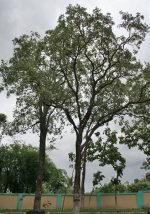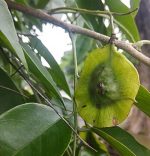 Endemic to the dry deciduous forests in the southern Eastern Ghats in South India, red sandalwood is also know as red sanders, Rakt Chandan, and saunderswood. It is a member of the pea family, Fabaceae, that also includes lupines, mimosa, and black locust. Growing 15-33′ tall, this small tree has dark brown fissured bark and alternate trifolate leaves that are 1-3.5″ long. Short dense racemes of yellow-green flowers appear from late winter to spring and give way to a winged seed pod 2.4-3.5″ long and containing 1-2 reddish- brown seeds. The tree has numberous medicinal uses and is highly valued for its timber that is used for such items furniture, building, carving and musical instruments. In addition, a red pigment derived from the wood is used as a food dye. High demand and illegal harvesting of the tree has caused it to be classified as a threatened species. The genus name, Pterocarpus, come from the Greek words pteron meaning wing and carpos meaning fruit and refers to the winged seed pod. The specific epither, santalinus, comes from the Greek word santalon, meaning the sandalwood tree. Photo Credit J M Garg Wikipedia
Endemic to the dry deciduous forests in the southern Eastern Ghats in South India, red sandalwood is also know as red sanders, Rakt Chandan, and saunderswood. It is a member of the pea family, Fabaceae, that also includes lupines, mimosa, and black locust. Growing 15-33′ tall, this small tree has dark brown fissured bark and alternate trifolate leaves that are 1-3.5″ long. Short dense racemes of yellow-green flowers appear from late winter to spring and give way to a winged seed pod 2.4-3.5″ long and containing 1-2 reddish- brown seeds. The tree has numberous medicinal uses and is highly valued for its timber that is used for such items furniture, building, carving and musical instruments. In addition, a red pigment derived from the wood is used as a food dye. High demand and illegal harvesting of the tree has caused it to be classified as a threatened species. The genus name, Pterocarpus, come from the Greek words pteron meaning wing and carpos meaning fruit and refers to the winged seed pod. The specific epither, santalinus, comes from the Greek word santalon, meaning the sandalwood tree. Photo Credit J M Garg Wikipedia
 Type: Tropical tree
Type: Tropical tree
Outstanding Feature:Wood
Form: Dense round crown
Growth Rate: Rapid when young; slower with maturity
Bloom: Dense racemes of yellow-green flowers from late winter to spring
Size:15-33 H’
Light: Full sun
Soil: Average to poor, medium moist with dry season, well-drained, acidic
Hardiness: Zones 9-13
Care: Low maintenance
Pests and Diseases: Leaf eating caterpillars
Propagation: Seed (viable for about 1 year)
Outstanding Selections: Unknown
Photo Credit: Aris-Riyanto-Wikipedia